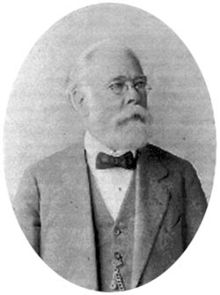Hermann von Ihering
| Hermann von Ihering | |
|---|---|

Hermann von Ihering
|
|
| Born | Hermann Friedrich Albrecht von Ihering 9 October 1850 Kiel |
| Died | 24 February 1930 (aged 79) Gießen |
| Residence | Brazil and Germany |
| Nationality | German |
| Known for | Hermann von Ihering |
Hermann von Ihering (9 October 1850 – 24 February 1930) was a German-Brazilian zoologist. He was the oldest son of Rudolf von Jhering.
Hermann Friedrich Albert von Ihering was born in 1850 in Kiel, Germany, being the oldest son of Rudolf von Jhering.
Under the advice of Rudolf Leuckart, Ihering studied medicine at the Giessen, Leipzig, Berlin, and Göttingen universities, working as an assistant at the zoological institute in Göttingen. He concluded his doctoral thesis in Göttingen, with the title Ueber das Wesen der Prognathie und ihr Verlhaeltniss zur Schaedelbasis (On the essence of prognathism and its effect on the base of the skull). He later worked as a Privatdozent for zoology at the Erlangen and Leipzig.
On 26 April 1880, Ihering married a widow, Anna Maria Clara Wolff (born von Bezel), who had a 10 year-old boy, Sebastian Wolff, from her first marriage. The marriage was not approved by Ihering's family and, as a result, he travelled to Brazil soon after. He got his first work at the National Museum of Rio de Janeiro, in Rio de Janeiro. However, as he found the climate of Rio de Janeiro too hot, he eventually moved to the city of Taquara, Rio Grande do Sul, where he started to collect specimens to send to museums in Germany and to the British Museum. At this time he had two children, Clara and Rodolpho. Later, he had other two, Wilhelm and Ida, but the latter died as a child.
In 1883, Ihering was nominated travelling naturalist of the National Museum of Rio de Janeiro and lived in several cities by the Lagoa dos Patos. He eventually bought an island at the delta of the Camaquã River, which started to be called Ilha do Doutor (Doctor's Island) and lived there for some years. He was naturalized Brazilian in 1885.
...
Wikipedia
